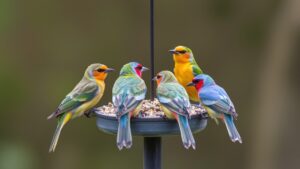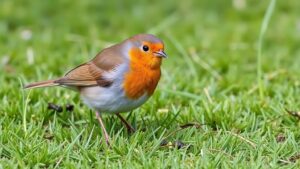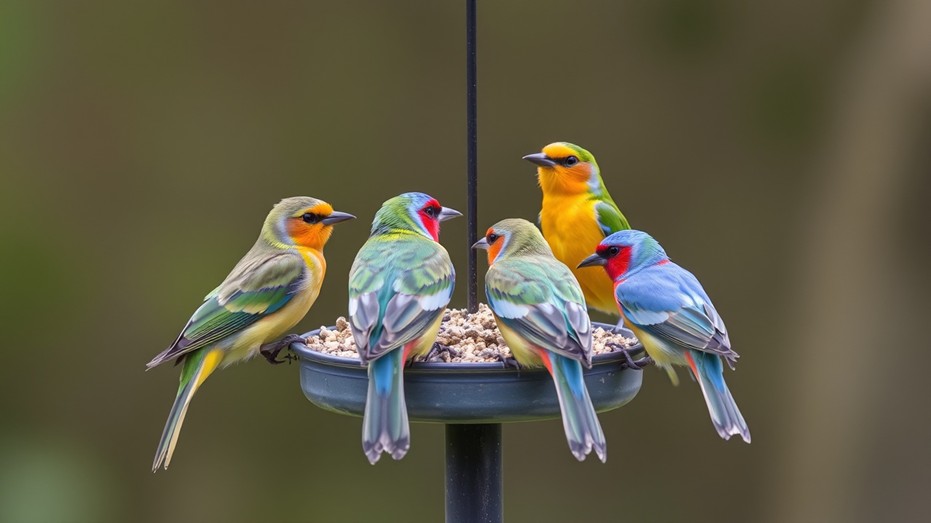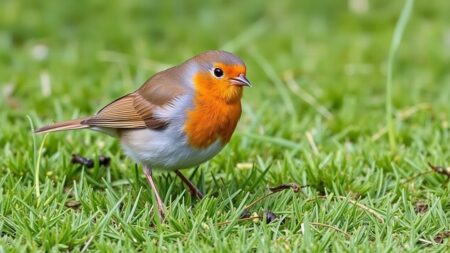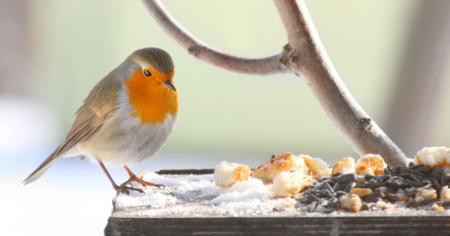If you want to know the importance of feeding birds in winter, you come to the right place. As temperatures drop and natural food sources dwindle, winter is a critical time to support our feathered friends.
Whether you feed titmice, finches, or jays, providing the right bird food is key to helping them thrive. Birds in the winter rely on high-energy options like cracked corn, millet, and a good mixed seed blend, which they will gobble up with delight.
Remember to offer birds protein-rich treats like peanuts and seed mix, which many feeder birds will eat eagerly. Providing water to birds with a heated bird bath is just as important as freezing temperatures can limit access to hydration.
From pet birds to wild species, the proper bird feeding routine ensures they stay healthy year-round. With these essential tips, you’ll discover how to feed birds in winter, spring, and summer, ensuring your backyard remains a bird haven every season.
Understanding How To Feed Birds In Winter
1. The Need for Food During Winter
Feeding birds in winter is vital to their well-being throughout the colder months, as food is scarce and energy is precious. During the winter, birds require much more food to maintain their energy levels and keep warm. Natural food sources like insects, seeds, and berries become limited, making backyard feeders a crucial resource.
The food you provide could differentiate between survival and starvation for many birds. Birds often rely on feeders during bad weather, as the easy-to-find and nutritious seeds help them conserve energy. You can significantly aid local bird populations during harsh winter conditions by offering a consistent food source.
2. How Birds Survive the Winter
Birds have developed several adaptations to survive winter. They fluff their feathers to trap heat and expose their backs to the sun for warmth. Their feet have a network of arteries and veins that minimize heat loss, allowing them to withstand cold temperatures.
Birds can fly to find food and escape severe weather quickly, which is a significant advantage over land-based animals. Birds also gather together to share body heat during cold nights, further enhancing their chances of survival in winter conditions. Understanding these survival strategies can help you choose the right foods for winter bird feeding, ensuring that birds find the necessary nourishment.
3. Common Backyard Birds in Winter
In winter, many colorful birds are active in backyards, including the Northern Cardinal, Blue Jay, and Red-breasted Nuthatch. These species provide a burst of color against a stark winter landscape and rely heavily on backyard feeders for sustenance.
Blue Jays enjoy peanuts, while Northern Cardinals favor black oil sunflower seeds. By understanding which birds frequent your area, you can tailor your winter bird feeding options to attract and support their survival. Common visitors like chickadees, sparrows, and goldfinches will flock to seed feeders, so offering a variety of birdseed and suet can help you effectively feed backyard birds in winter.
Choosing the Right Feeder
1. Types of Bird Feeders
The right bird feeder can make all the difference in feeding birds effectively in winter. Winter brings unique challenges, from snow to freezing temperatures, so choosing feeders that protect food and make it easy for birds to access is essential. Selecting the right type ensures that your feathered visitors can enjoy a steady supply of nourishment, even in the harshest conditions.
Here are some popular types of bird feeders perfect for the winter season:
- Hopper Feeders: Sturdy and weather-resistant, these feeders store seeds in a compartment and dispense them as birds feed. They keep bird food dry and accessible.
- Tube Feeders: Designed for smaller seeds like millet, these feeders attract small birds like titmice and finches.
- Suet Feeders: Ideal for high-energy suet cakes, these are great for winter, providing fat-rich food birds will eat.
- Platform Feeders: Simple yet effective, these open feeders allow birds to gobble up seeds and cracked corn.
- Heated Bird Baths with Feeder Combo: Perfect for offering water and food simultaneously during freezing winters.
2. Best Locations for Bird Feeders
Strategic placement of bird feeders can greatly enhance birds’ visibility and accessibility during the winter months. Ideally, your feeders should be 10-12 feet away from shrubs or brush piles where predators like cats can hide. This distance ensures that your backyard birds feel safe while feeding.
Placing feeders where they are visible from your windows allows you to enjoy watching your feathered friends up close. Choosing sunny spots keeps the food dry and makes it more accessible, especially during cold winter. Regularly checking and refilling feeders will help keep them attractive to wild birds, ensuring they have the necessary nourishment.
3. Maintaining Your Bird Feeder
Proper bird feeder maintenance is crucial for visiting birds’ health and well-being throughout the winter. To prevent spreading diseases that can affect birds, it is best to clean your feeders at least every two weeks with a mixture of 9 parts water and 1 part bleach.
Ensure the feeders are completely dry before refilling them with fresh birdseed or peanuts. It is vital to remove uneaten seeds or debris that can harbor mold or attract pests like squirrels, which may compete with birds for food. Using a pole with a hook can make removing and refilling feeders easier, allowing you to keep your feeders in good condition and provide a reliable food source for the many birds that visit your yard.
Foods for Winter Bird Feeding
1. Top Birdseed Options for Winter
Offering various bird seed options is essential for winter bird feeding, as it can attract a diverse range of species to your feeders. Due to their high nutritional value, black oil sunflower seeds are particularly popular among many birds, including the vibrant Northern Cardinals and the lively House Finches.
Safflower seeds are another excellent choice, especially if you want to deter squirrels, as they are less appealing to these critters. Additionally, Nyjer seeds are perfect for attracting finches, while peanuts serve as a high-protein food source that many birds love.
It’s advisable to avoid seeds that primarily contain oats or milo, as birds typically do not consume these grains. By diversifying the types of seeds you offer, you can ensure that your backyard bird feeder becomes a go-to food source for the myriad of winter birds seeking nourishment.
2. The Benefits of Suet for Wild Birds
Suet is a powerhouse of energy, especially beneficial during winter when birds need extra calories to maintain their body heat. Suet cakes, crafted from rendered beef fat combined with seeds and grains, attract various species, including woodpeckers, nuthatches, and chickadees.
Providing suet can significantly help birds survive the coldest months, especially in regions where temperatures plummet. Dedicated suet feeders can be easily hung in your yard, making it convenient for birds to access this vital food source.
The energy-rich nature of suet is particularly important in colder climates, where birds’ metabolisms require more energy to thrive. By including suet in your winter bird feeding regimen, you can support the well-being of your feathered friends and witness a greater diversity of bird species visiting your yard.
3. One Type of Food: Why Variety Matters
Offering a variety of foods is crucial for winter bird feeding, as it helps attract different bird species and meets their unique nutritional needs. Each bird has its preferences; for instance, some prefer seeds, while others enjoy fruits or suet.
By providing a mix of seeds, nuts, dried fruit, and suet, you can cater to a broader range of birds in your backyard. Introducing new food types regularly can also encourage frequent visits and enhance the overall biodiversity in your yard.
The variety attracts birds like goldfinches and sparrows and provides essential nutrition to support their survival through the winter months. This approach ensures that your feeders are not just a food source but a vibrant hub for wild birds seeking sustenance and community.
Tips for Feeding Backyard Birds in Winter
1. How to Attract Birds in Winter?
To attract birds to your backyard in winter, it’s crucial to ensure that your feeders are consistently stocked with fresh food. Many birds may take time to discover new feeders, so patience is essential. An effective strategy to enhance your feeding setup is to place birdbaths nearby, as these water sources can initially draw birds.
Natural cover, such as evergreen shrubs or brush piles, can make your yard more appealing by offering shelter from harsh winter elements. By creating a welcoming environment, you can entice various bird species to visit your feeders regularly throughout winter.
2. Feeding Birds During Snow and Ice
During periods of snow and ice, birds heavily rely on your feeders as natural food sources become buried and inaccessible. It’s vital to ensure that your feeders remain easily accessible and are regularly filled with nutritious foods like black oil sunflower seeds and suet.
Consider placing a heated birdbath nearby to provide fresh water, as hydration is just as important as food. If snow accumulates on your feeders, be proactive in brushing it off to allow birds easy access to their food. Breaking up any ice that forms on birdbaths is essential to ensure that birds can hydrate effectively during harsh winter.
3. Creating a Winter Bird-Friendly Environment
Creating a bird-friendly environment involves more than just providing food; it also includes enhancing your yard with native plant species that produce seeds and berries during winter. Planting evergreen trees and shrubs offers essential shelter from wind and predators, making your space more inviting for backyard birds.
Constructing brush piles or providing birdhouses can create safe roosting spots for birds during cold nights. These efforts will attract various birds and contribute to their overall well-being throughout the winter months, helping them survive the winter and thrive until spring.
Conclusion
Feeding birds in winter is essential for survival as natural food sources diminish. By providing a variety of seeds, suet, and fresh water, you can help sustain them through the cold months.
Choosing the right feeders, maintaining them, and placing them in optimal locations are crucial to attracting and supporting winter birds.
Remember to be patient, as it may take time for birds to discover your feeders. With consistent care, your backyard can become a vital food source for many birds during these challenging times.
By feeding backyard birds in winter, you contribute to their survival and well-being and enjoy the beauty and activity they bring to your outdoor space. Your efforts can make a significant difference in the lives of local bird populations, especially during harsh weather conditions.
Encourage your friends and family to join you in this rewarding activity, which fosters a deeper appreciation for wildlife and the natural world. Watching these feathered friends visit your feeders during winter can provide joy and a connection to nature.
Winter bird feeding is a fulfilling way to connect with nature and support local wildlife. As you observe the diverse species visiting your feeders, you’ll gain insight into their behaviors and needs. Remember that feeding birds is not just a winter activity.
Maintaining feeders year-round can enhance your garden’s ecosystem and attract birds during all seasons. Enjoy the beauty of nature and the joy of birdwatching in your backyard, knowing that your efforts are helping to sustain these incredible creatures through the challenging winter months.


